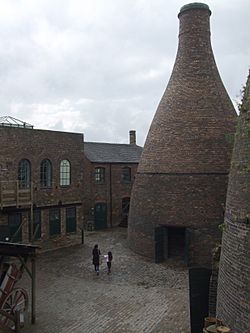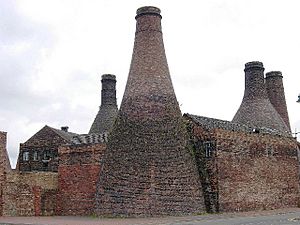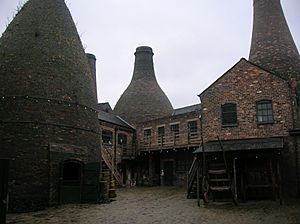Gladstone Pottery Museum facts for kids

The courtyard and bottle kiln
|
|
| Lua error in Module:Location_map at line 420: attempt to index field 'wikibase' (a nil value). | |
| Established | 1974 |
|---|---|
| Location | Longton, Staffordshire, England |
| Type | Industrial museum |
| Public transit access | Longton railway station 10 mins by foot |
The Gladstone Pottery Museum is a special place in Longton, Stoke-on-Trent, England. It is a museum that shows how pottery was made a long time ago. This museum is set up in an old pottery factory that used to make things like plates and bowls. It shows what a typical pottery factory looked like in the North Staffordshire area from the 1700s to the mid-1900s.
The museum buildings are very important. They are listed as a Grade II* building, which means they are historically special. The museum is also part of the European Route of Industrial Heritage, which connects important industrial sites across Europe. Even though it's called Gladstone, the museum actually includes buildings from two old factories: Gladstone and Roslyn. The tall, bottle-shaped kilns, which are ovens for firing pottery, are very rare. There are fewer than 50 of these "bottle ovens" left in Stoke-on-Trent, so the ones at the museum are a big part of the UK's history. In 1976, the Gladstone Pottery Museum won the National Heritage Museum of the Year award.
Contents
History of the Pottery
A pottery factory first opened on this site in 1787. It was run by the Shelley family. They made earthenware and decorated plates. In 1789, William Ward bought the site. He divided it into two separate factories. One was called Park Place Works, later known as Roslyn works. The other was Wards Pot Bank.
In 1818, John Hendley Sheridan bought Wards Pot Bank. By the 1850s, Thomas Cooper was renting the factory from Sheridan. Cooper had 41 adults and 26 children working there. They made fine china and Parian figures, which are like statues.
By 1876, the Wards factory was owned by R. Hobson and Co. They renamed it Gladstone. This name came from a famous politician named William Ewart Gladstone.
From Factory to Museum
The factory stopped making pottery in 1970. Its special bottle ovens were last used about ten years before that. The buildings were almost torn down. But they were saved! The factory then opened as a museum in 1974.
In the 1990s, the Stoke-on-Trent City Council took over the museum. The museum used to make pottery as a working factory. This helped visitors see how things were done. However, making pottery became too expensive. So, the museum now does less actual production. Today, the Middleport Pottery in Burslem is the main working Victorian pottery in Stoke-on-Trent.
How Tableware Was Made
Making pottery was a long process. First, clay and ground bone were mixed in a place called the sliphouse. This made a liquid clay called slip. Bowls, plates, and saucers were shaped from this slip. They were either pressed, jiggered, jolleyed, or moulded.
The newly shaped pottery was called "green" because it had not been fired yet. It was left to dry in the greenhouse. At the same time, special clay boxes called saggars were made. These saggars would hold the pottery inside the kiln.
Firing the Pottery
The bottle oven kiln has an outer hovel. This helps hot air rise. The biscuit kiln was filled with saggars. These saggars held the green pottery. Workers called placers carefully put them inside. The kiln doors, called clammins, were then bricked up.
The firing process then began. Each firing used about 14 tons of coal! Fires were lit in the firemouths. Workers added more coal every four hours. Flames went up inside the kilns. Heat passed between stacks of saggars, called bungs. Workers controlled the heat using dampers at the top of the kiln. They checked the temperature by watching special rings called bullers rings. A kiln would get as hot as 1250 degrees Celsius.
After the first firing, the pottery was called "biscuitware." It was then covered with a glaze. Then, it was fired again in bigger glost kilns. Again, the items were placed in sealed saggars. Special kiln furniture like stints, saddles, and thimbles kept items separate. After this, the tableware was decorated. This was done with transfers or by painting. Finally, it went into a muffle kiln.
The enamel kiln (or muffle kiln) was built differently. It fired at a lower temperature, around 700 degrees Celsius. Pots were stacked on 7 or 8 levels of clay bats (shelves). The door was made of iron lined with bricks.
Once the kiln cooled, the finished pottery was packed into baskets. It was then sent to different parts of the country and the world. This was done using the Trent and Mersey Canal and ports on the River Mersey.
Museum Buildings and Displays
The museum is mainly built around the old Roslyn pottery. It has two biscuit ovens and two larger glost ovens. There are also two enamel kilns. The museum has a large steam engine. It was made by Marshall & Sons. Today, an electric motor turns it. Two muffle kilns were brought to the museum from other places.
What You Can See
Visitors can explore the tall bottle kilns. You can also see important rooms like the engine house and the slip room. There is a workshop where saggars were made. The museum shows how clay was worked. You can even try throwing clay on a wheel! There are also displays about how pottery was colored and gilded.
There is a special gallery that tells the story of tiles. It shows how tiles were pressed, glazed, and decorated. You can see a famous piece called the "Gladstone Vase" by Frederick Alfred Rhead.
Another gallery shows the history of sanitary ware. This includes old toilets and washbasins.
Media and Events
The Gladstone Pottery Museum has been featured on TV many times. Tony Robinson filmed a BBC show there. Alan Titchmarsh also visited. The museum often has visits from the Blue Peter crew. Many children's TV shows have filmed there too.
In 1986, parts of the Doctor Who show The Trial of a Time Lord were filmed at the museum. In the early 1990s, it was on Noel's House Party. The museum was also featured on the TV series "Most Haunted." In 2015, it was part of the BBC One show 24 Hours in the Past. This show had celebrities working in Victorian times.
Since 2020, The Great Pottery Throw Down has been filmed at the museum. Before that, it was filmed at Middleport Pottery. In 2021, the museum was used for two Netflix TV series. These were The Irregulars, based on Sherlock Holmes stories, and The Colour Room, about pottery designer Clarice Cliff.
Fun Events at the Museum
The museum holds many fun events each year. These include Halloween ghost walks and tours. They also have Christmas Carol Concerts and seasonal festivals. For children, there are Egg Easter Hunts and Summer Pottery workshops.
See also
- Burleigh Pottery



